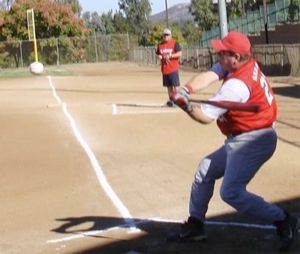health & sports
Out on the Field
After beating cancer, Strehlow returns to the field
Published Thursday, 27-Mar-2008 in issue 1057
Wyatt Strehlow is a pretty private guy. One of the ways to get to know him is through softball. He’s a softball player, and it’s fair to say that sports, in part, define him. It’s easy to understand why.
Growing up, he was an athlete, playing mostly in church leagues.
As an adult, he became involved in the gay softball league in his home town, Long Beach. Shortly after moving to San Diego in 1995, Strehlow joined the local league, America’s Finest City Softball League.
On Sunday, March 30, Strehlow will take the softball field for his 13th consecutive season. This time around, though, it might mean more than it ever has before.
Strehlow was diagnosed with cancer on October 5, 2007. He went to see his doctor for a routine follow-up to a minor surgical procedure he had weeks before.
“The first words out of the doctor’s mouth were, ‘Well, we found cancer,’” he said.
Strehlow was dumbfounded.
“The first words out of my mouth were, ‘I didn’t know we were looking for it,’” he said.
The surgeon biopsied an ulcer he found during surgery and detected the cancer.
“The doctor talked for a few minutes, giving me an idea of what was going to be happening, but I was pretty stunned,” Strehlow said.
The days that followed included a dizzying schedule of doctors’ appointments and tests, and resulted in more than a few frayed nerves.
Shortly after, Strehlow was given a clear diagnosis. He had rectal cancer, and it had spread to his left lymph nodes near his groin. Once in the lymph nodes, cancer spreads quickly, so Strehlow’s doctors acted quickly.
Within two weeks he began treatment, which included 33 daily radiation treatments and two rounds of chemotherapy, each lasting five continuous days.
Strehlow couldn’t work. In fact, he could barely walk around his house. During the first week of chemotherapy he hardly had the energy to walk to the car and be driven to the doctor for his radiation appointments.
Softball was out of the question – and Strehlow couldn’t help but wonder if he’d ever play again.
“Whenever you hear the word cancer, you always think of death,” Strehlow said. “Even though you try to put it out of your head, you still wonder.”
According to his doctors, Strehlow had little more than a 60 percent chance of the treatment being successful. If it wasn’t, tests would reveal the failure quickly, and surgery was a last resort.
Surgery, however, would mean softball and all other sports would be out of the question for Strehlow. So, he fought it – with the help of his closest friends and teammates. He received phone calls and e-mails and well wishes from members of his team, and even players he’d competed against in the past.
Strehlow got lucky. The cancer stopped spreading, and the treatment was successful.
As he recovers, he is just now getting back to work and is looking forward to starting the softball season.
The Flicks-sponsored team he’s played for the last five years is hoping to compete in the highest division and hopes to compete for a World Series berth. Strehlow, primarily a pitcher, knows that to be effective he’s going to have to give 100 percent-plus and leave nothing in the tank.
To a degree, that’s a concern for the big lefty.
“One of the side effects of the treatment is fatigue. I still get tired,” he said.
But, Strehlow says, after beating cancer, “being tired isn’t going to keep me off the softball field. If I get tired, I’ll just sit down.”
Strehlow, who is a very private person, only shared his story because I asked, and he is one of my closest friends. He tries to avoid the spotlight, but his story was too important not to be told; as are the stories of James Riggins, a wheelchair-bound bowler who bowls in the gay bowling league; and Lindsay Hood, who plays professional football with a prosthetic leg.
And if they’re doing it, why aren’t you?
|
|
Copyright © 2003-2025 Uptown Publications


